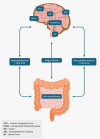The brain-gut axis and chronic pain: mechanisms and therapeutic opportunities
- PMID: 40027466
- PMCID: PMC11868272
- DOI: 10.3389/fnins.2025.1545997
The brain-gut axis and chronic pain: mechanisms and therapeutic opportunities
Abstract
The brain-gut axis (BGA) is emerging as a critical mediator in chronic pain, involving bidirectional communication between the central nervous system and the gastrointestinal system. The "Pain Matrix" is associated with microbial dysbiosis, vagus nerve dysfunction, and hypothalamic-pituitary-adrenal (HPA) axis dysregulation, driving neuroinflammation and central sensitization. Key mechanisms include microbial diversity loss, leaky gut, and altered neuroactive signaling via short-chain fatty acids (SCFAs) and vagal pathways. This narrative review explores the intricate interplay between BGA mechanisms and chronic pain, highlighting therapeutic opportunities such as restoring dysbiosis, modulating vagus nerve activity, and regulating endocrine pathways. These interventions target inflammation, autonomic balance, and stress/reward pathway modulation, offering a promising path toward integrative pain management. Further research is required to validate these strategies and improve patient outcomes.
Keywords: HPA–hypothalamic-pituitary-adrenal; brain-gut axis; chronic pain; microbiome; vagus nerve.
Copyright © 2025 Ho, Elma, Kocanda, Brain, Lam, Kanhere and Dong.
Conflict of interest statement
The authors declare that the research was conducted in the absence of any commercial or financial relationships that could be construed as a potential conflict of interest.
Figures
References
Publication types
LinkOut - more resources
Full Text Sources


